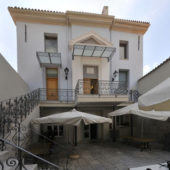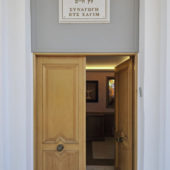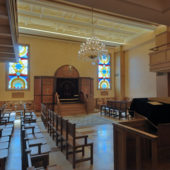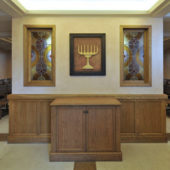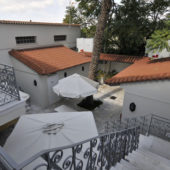The oldest synagogue in Athens, the Ioanniotiki Synagogue, was built by Romaniote Jews from Ioannina.
The earliest written reference to a Greek Jew is c. 200-300 BCE in Oropos, a small coastal town between Athens and Boeotia, where an inscription refers to, “Moschos, son of Moschion the Jew,” who may have been a slave. Romaniotes are distinctly Greek Jews, unlike Sephardic or Ashkenazic Jews. It is possible that they have lived in Greece from as far back as the Babylonian exile. Romaniote oral tradition advises that the first Jews arrived in Ionnina just after the destruction of the temple in Jerusalem in 70 CE. By the 12th century, there were recorded communities of Jews in Corfu, Arta, Aphilon, Patras, Corinth, Thebes, Chalkis, Thessaloniki and Drama.
Because of the pagan associations of Athens, after the destruction of the ancient synagogue in the Agora in the 5th century, Jews chose not to continue to settle there until the 19th century, at which time a new synagogue was built. Romaniotes’ customs were very distinct from those of Sephardic and Ashkenazi Jews, more similar to those of Italian Jews. A possible explanation being that they used the Jerusalem Talmud instead of the Babylonian Talmud. They also spoke Greek, not Hebrew or Yiddish. The wage earners were largely lower class trades and craftsmen: cloth dyers and weavers, makers of silk garments, porters, street venders and owners of small shops. They were not well educated, most young men had to leave school early in order to help support their families, and most girls had no education at all. In 1492 waves of Sephardic Jews were expelled from Spain, and many fled to Greece. They were richer and believed themselves to be more educated and sophisticated than the Romaniotes; therefore, they formed separate communities.
During WWII, the Greek islands were occupied by the Nazis and 86% of the Greek Jews were murdered, in spite of the often heroic efforts of the Greek Orthodox Church and other Christians to hide them. There were 3,000 Jews living in Athens alone, plus the Jews fleeing through it as the Germans were taking over. Because Athens was an Italian Zone of Occupation, this gave the Jews more time to prepare for the Nazi’s arrival. Due to the efforts of the Greek Orthodox Church and the Chief Rabbi of Athens, many of the Jews hidden throughout the city were saved from the Holocaust. After Israel became a nation in 1948, most of the remaining Jews in Greece emigrated there. Today, the only Romaniote communities in mainland Greece are in Ionnina and Athens. There are approximately 50 Romaniotes in Ionnina. The remainder of the Romaniotes live in either Israel or the U.S. (mainly New York). Although they identify themselves as Romaniotes, they use the Sephardic rite because the distinctive Romaniote rite has not survived, except for a few hymns used by communities such as on Corfu. Approximately 4,500 to 6,000 Jews live in Greece today, of both the Romaniote and Sephardic traditions. Most of these live in Athens.
There is only one Romaniote synagogue in Athens, the Ionniotiki Synagogue. It is also the oldest synagogue in the city. Built in 1903, there are only enough Romaniotes in Athens today to support the Synagogue holding services on High Holy Days; however, it is available for visitors on request through the Jewish Community Office. The layout is traditionally Romaniote, with the bimah on the western wall and the Aron Kodesh on the eastern wall. The Torah scrolls are kept in tikkim, wooden and metal cases, typical to Romaniote tradition.
The exterior is an attractive modern neo-classical design, featuring a white façade with cream moldings. Black wrought iron balconies and railings run across the entire front of the Synagogue, encompassing an inviting patio area with paving stones and large umbrellas. The spacious prayer room is also decorated in a modern neo-classical design, implementing Jewish symbols into the design structure. The ceiling is cream with a tan alternating molded symbols of Stars-of-David and octagons. The floor features a large cream Star-of-David against a tan background. The Aron Kodesh against the west wall is a beautifully carved structure in three tones of wood, with important Jewish elements carved and gilded in gold. A maroon Torah curtain with gold embroidery is drawn across it. Rectangular, stained-glass windows featuring modern designs flank either side of the Aron Kodesh. On the opposite side of the room sits the bimah. Wood panels surround the bimah, with a darker, ornamental piece of wood on the front, featuring a menorah and other beautiful carvings, which are gilded in gold. Inside are the tivah (reader’s desk) and several chairs and it is open to the back. Behind it is a small wall with two smaller versions of the stained-glass windows on either side of the Aron-Kodesh. The women’s gallery is upstairs, running along the sides and back of the sanctuary featuring striking wood paneling.

